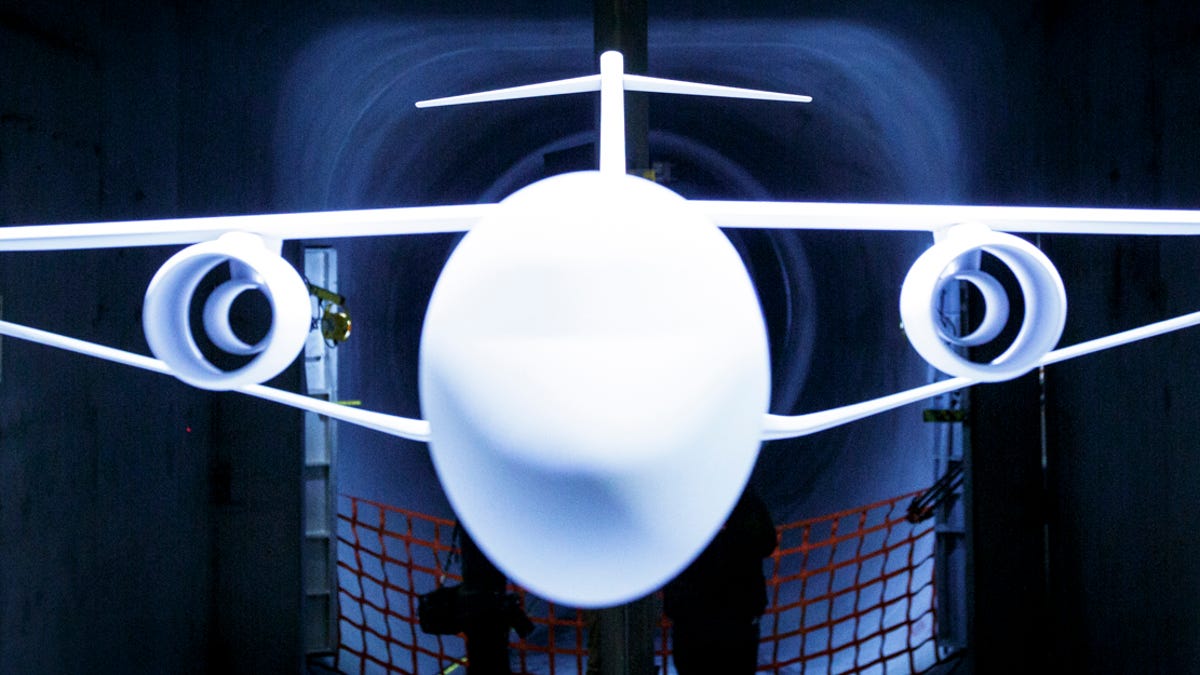Faster, quieter, cleaner: How NASA imagines the 737 of 2035
Beyond getting to Mars in two decades, the space agency has another mission: upgrading the commercial jet before the Europeans and Chinese.

Flying the friendly skies might actually become more than a slogan. Just give it two decades.
If you can handle the wait, a ride on the likes of a Boeing 737 will get slightly faster and a whole lot quieter and cleaner by the mid-2030s, according to NASA.
The American space agency gave reporters a glimpse of the future of commercial air travel from inside a wind tunnel last week at NASA's Ames Research Center in Silicon Valley. An all-white, windowless, 4-foot-long model plane with higher-than-usual wings was suspended in the tunnel where just last month NASA first began testing its design in winds exceeding the speed of sound.
"This particular airplane...could knock the socks off of a Boeing 737," said NASA's Nateri Madavan, a project manager at Ames overseeing the plane's design. "It will cut fuel use by more than 50 percent. It will cut emissions by more than 80 percent. It'll cut noise by a factor of six. It's truly a revolutionary airplane."
NASA may be the agency in charge of sending us into space, but it also has very earthly concerns. The 58-year-old program is gearing up to land humans on Mars in the 2030s, but it's also focused on upgrading the commercial jet for the 21st century -- and doing so before anyone else.
"We might just help to save our planet," NASA chief administrator Charles Bolden told reporters in a cavernous room just outside a wind tunnel.
Two facts have NASA seeing green these days.
The space agency expects that twice as many people will be hopping on airplanes by 2030. That means more fuel consumption and more carbon emissions, unless planes get an upgrade.
There is also a lot of money on the line. Rising demand for new commercial planes has been a boon for US-based Boeing and Europe-based Airbus Group in recent years. In fact, even as orders for military planes faltered in 2014, Airbus saw a nearly 60 percent jump in profit that year because of strong demand for passenger jets.
Beyond traditional competitors like Airbus, said Madavan, "we face newcomers like China and Japan who are chomping on the bit for a piece of this market."
So NASA wants to tip the scales of the global jet race toward the US.
Beginning in 2009, the $19 billion-a-year federal agency threw its weight behind ways to create leaner and greener passenger jets. Along the way, it partnered with US airplane and engine makers, universities and other government agencies to create several models that have reimagined the basic design of the commercial jetliner as we know it.
NASA has focused in particular on overcoming the thunder-like sonic booms created by planes exceeding the speed of sound. Fixing that problem, the agency believes, could make supersonic commercial jets a viable option. Then, noise-sensitive airports might welcome supersonic planes like the Concorde rather than ban them.
The design unveiled February 18 came from a group led by Boeing as part of an effort dubbed SUGAR, or Subsonic Ultra Green Aircraft Research.
General Electric and the US Air Force are also part of the group, which deliberately set out to create a plane to replace the 737 that has been continuously manufactured by Boeing since its debut in 1967.
NASA's future 737 replacement achieves the efficiency and quiet that eludes current models by using longer, narrower wings. Those changes also make the plane look more like high-winged, small personal aircraft such as Cessna 172 or Piper Cub than like the sleek, low-winged commercial jets people are used to.
To support the longer wingspan, the model plane uses struts, or trusses, connecting the underbelly of the plane to the wings. Hence, NASA's name for the concept is the truss-braced wing.
Madavan said the plane in its current configuration could travel at three-quarters the speed of sound, or about 576 miles per hour. That's about how fast the 737 travels today. But Madavan expects the redesigned plane could travel even faster, reaching 652 miles per hour, or about 85 percent of the speed of sound.
There's a lot more to be done before we're traveling inside NASA's vision for friendlier skies. Its model plane doesn't have windows, and the twin engines are still far from being built, according to Madavan.
But NASA's chief administrator thinks his agency can deliver.
"If all this sounds like science fiction," Bolden said, "the people at NASA turn science fiction into fact."

